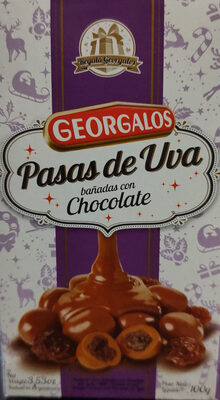Pasas de uva bañadas en chocolate - Georgalos - 100 g
This product page is not complete. You can help to complete it by editing it and adding more data from the photos we have, or by taking more photos using the app for Android or iPhone/iPad. Thank you!
×
Barcode: 7790380037002 (EAN / EAN-13)
Quantity: 100 g
Brands: Georgalos
Categories: Snacks, Sweet snacks, Cocoa and its products, Confectioneries, Chocolate candies, Bonbons, Fruit confectioneries, Chocolate covered fruits, Chocolate-covered raisins
Labels, certifications, awards: Pure cocoa butter
Origin of ingredients: Argentina
Countries where sold: Argentina
Matching with your preferences
Environment
Packaging
Transportation
Report a problem
Data sources
Product added on by flipwared
Last edit of product page on by flipwared.
Product page also edited by ecoscore-impact-estimator, openfoodfacts-contributors.
If the data is incomplete or incorrect, you can complete or correct it by editing this page.










